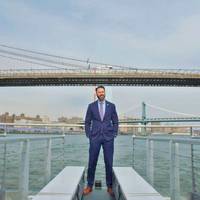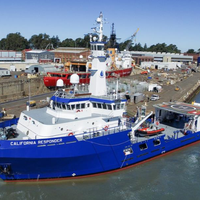Brendan Smith Takes the Helm as President, Seaward Services

Hornblower Group announced that Brendan Smith, formerly VP of Engineering, NYC Ferry, has been named President of Seaward Services, Inc. Smith replaces John Keever, who has retired after 50 years in the industry, and will report to Scott Thornton, COO of Hornblower Group’s Ferries and Transportation Division.As President of Seaward Services, Inc., Smith will oversee the operation and maintenance of both government and privately owned craft, including High-Speed Craft, Range Craft, Experimental Craft, Training Craft, Research Vessels and Unmanned Surface Vessels.
Hornblower Acquires Two Offshore Vessels

Hornblower Group announced on Wednesday it has acquired two offshore vessels: the Seaward Explorer and Seaward Endeavor, previously the California Responder and Pacific Responder, respectively. Seaward Services, Inc. (SSI), part of the Hornblower Group of maritime businesses, is offering the multipurpose supply vessels for charter, with prompt availability.The Seaward Explorer and Seaward Endeavor were built at VT Halter Marine in Mississippi, commissioned by Marine Spill Response Company (MSRC) in response to the Exxon Valdez oil spill.
Seaward Provides Bridge Officers for LCS and JHSV Sea Trials
Seaward Services provides bridge officers, including the master and chief engineer, for Builder and Acceptance Trials of the Navy’s Littoral Combat Ship (LCS) and Joint High Speed Vessel (JHSV). USNS Choctaw County, the Navy's second Joint High Speed Vessel (JHSV 2), satisfactorily completed Acceptance Trials, May 3 in Mobile, Ala. under the command of Seaward Services’ master, supported by the company’s chief engineer and other deck and engine officers. During Acceptance Trials the ship's major systems and equipment were tested and evaluated, including a full power run and demonstrations of main propulsion engineering and ship control systems, anchoring, emergency and crew support systems. The ship reached speeds of over 40 knots during at-sea trials.
HMS Global Maritime Extends Westpac Express Contract
HMS Global Maritime (HMSGM) announce the extension of the HSV WestPac Express’ charter with the U.S. Navy’s Military Sealift Command (MSC) and the Third Marine Expeditionary Force, beginning in February 2012. The contract can last up to an additional two years. The HSV WestPac Express has been operated by HMSGM for the past nine years as a high-speed transport vessel for military personnel and equipment over a 1,200 mile range in Asia. The 101-meter vessel, home ported in Okinawa, Japan, can carry 970 troops and 236 vehicles at speeds of 35 knots. Over the past nine years, the HSV WestPac Express has experienced many achievements. One of those achievements came in March…
Keever Named Director for Hawaii SuperFerry
Hornblower Marine Services (HMS) is pleased to announce Captain John M. Keever is joining the company as Director of Marine Operations for the Hawaii Superferry project. As Director of Marine Operations for Hawaii Superferry, Captain Keever will manage the Alakai, the world’s most celebrated high-speed vessel, providing long-awaited passenger ferry service between , O’ahu and . This project is at the cutting edge of the high-speed passenger vessel industry, requiring top notch leadership, experience and innovation. Keever currently serves as Vice President, Marine Programs and Student Development of the , now part of The California State University. He is also a tenured professor of maritime management and serves as the campus’ federal liaison to the U.S.
Lawmakers Consider Tougher Safety Rules for Ships
Bay Area members of Congress suggested that tougher safeguards might be needed on cargo ships to prevent accidents like the recent Cosco Busan spill that resulted in 58,000 gallons of heavy bunker fuel in San Francisco Bay. One possibility would be to require double-skins on fuel tanks or some sort of partial double hull on cargo ships. In response to the disastrous Exxon Valdez spill in Alaska in 1989, all oil tankers in U.S. waters must have double hulls by 2015. Another would be to make the Coast Guard's vessel transport system more stringent for ships entering and leaving ports, like the air traffic control system. Though the Cosco Busan did not have a double hull…







